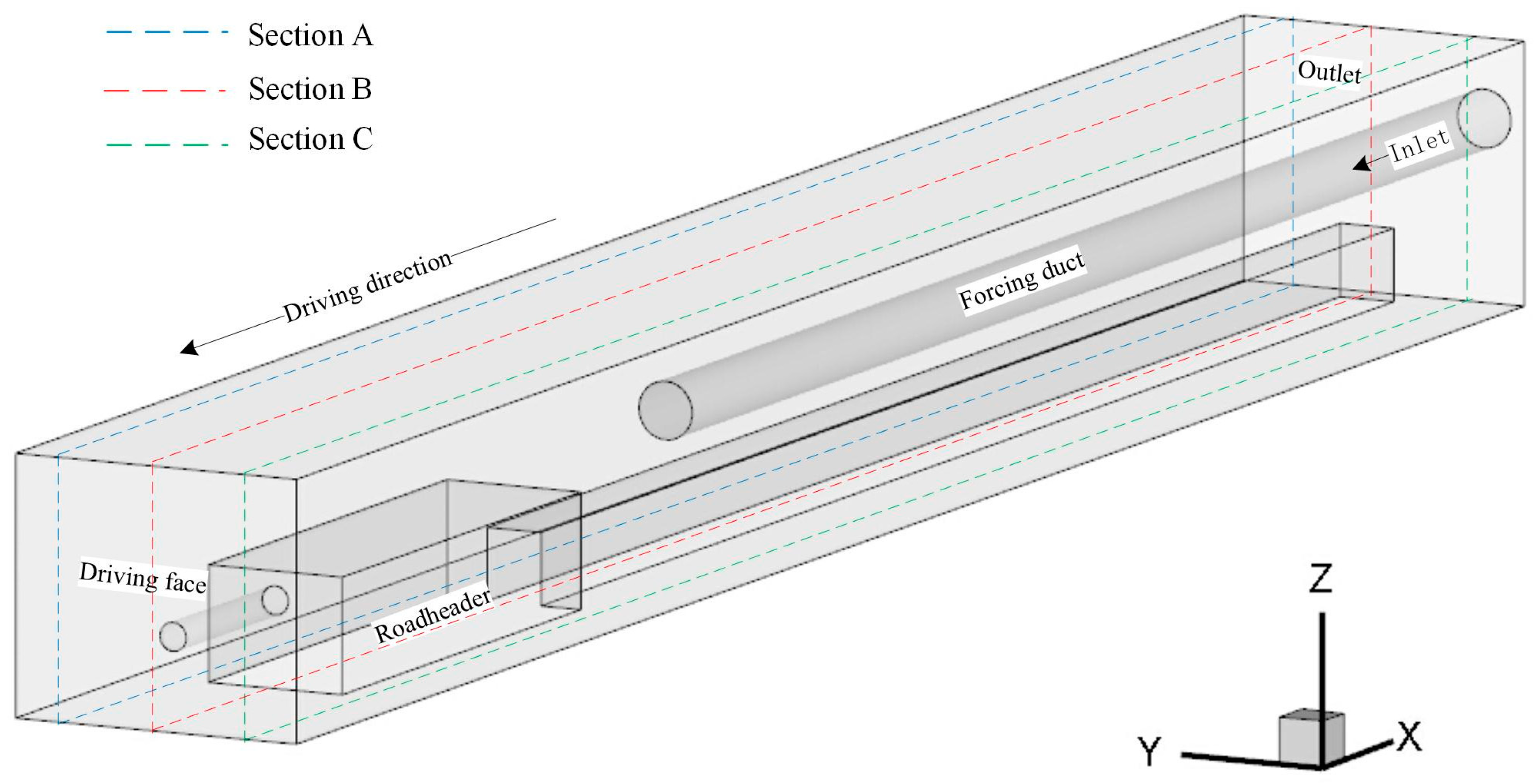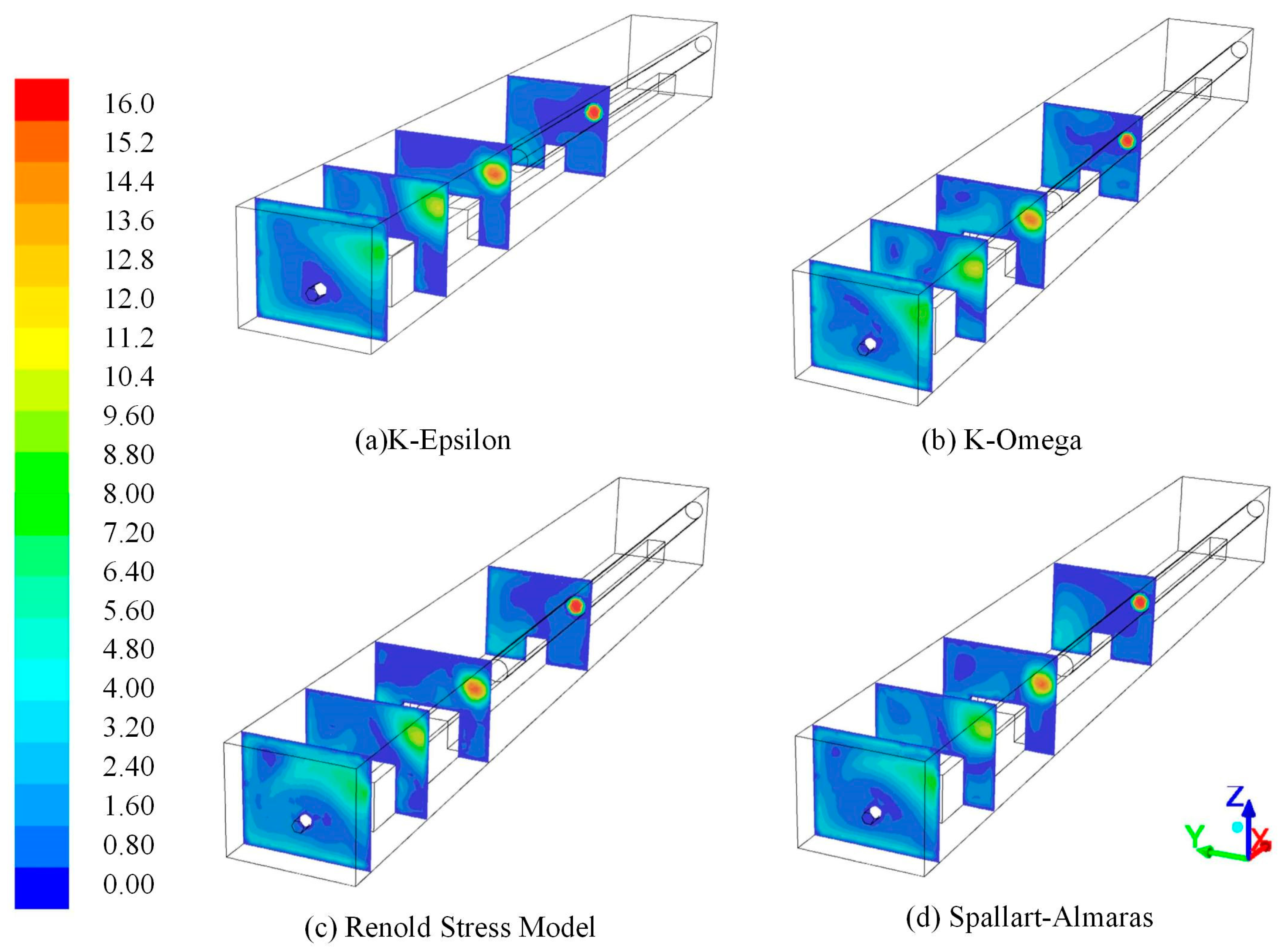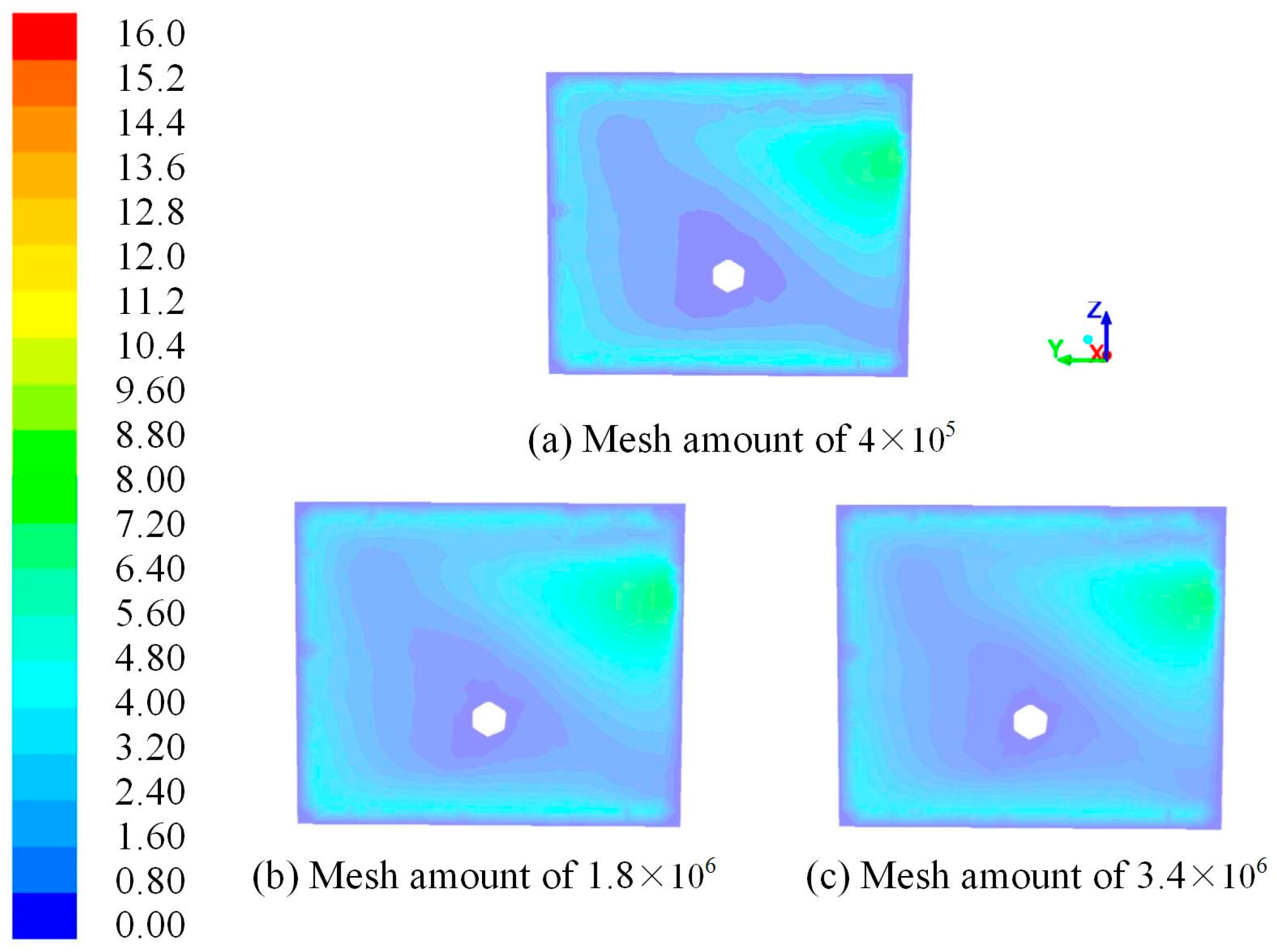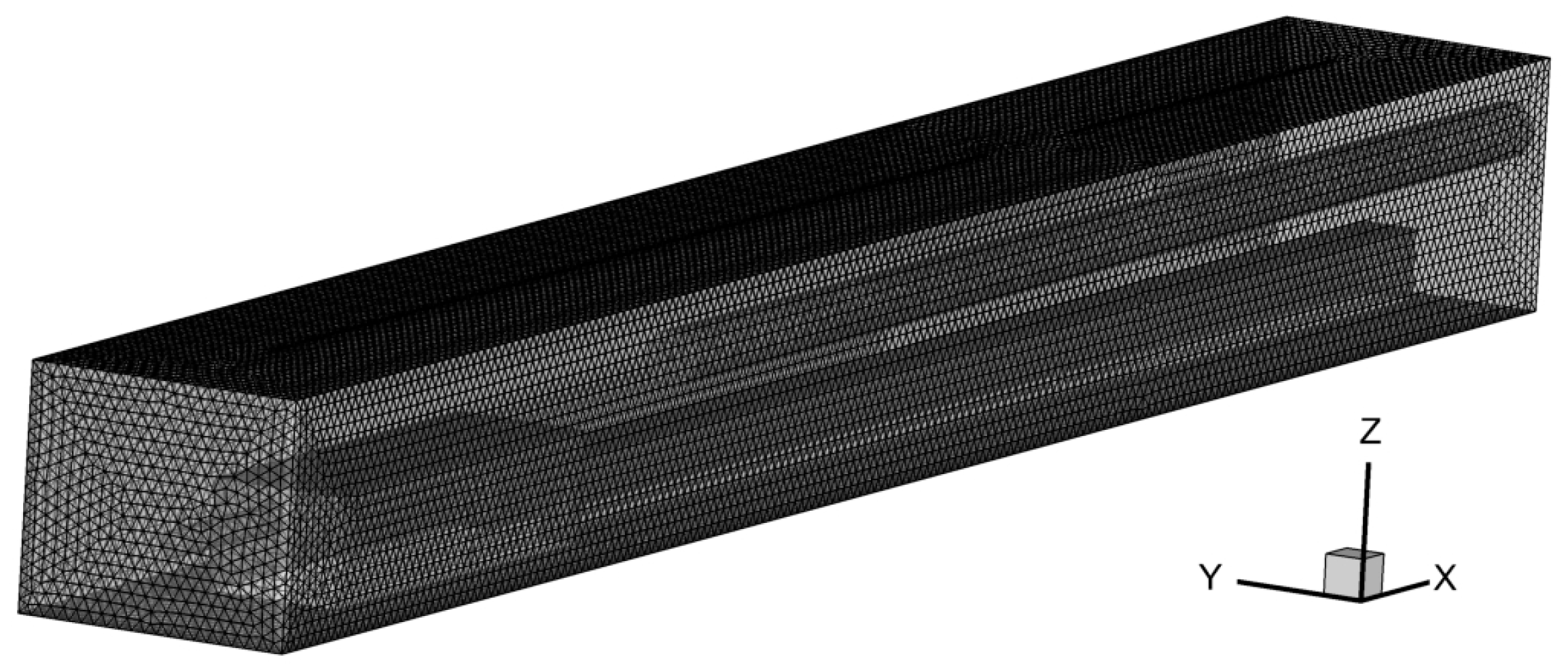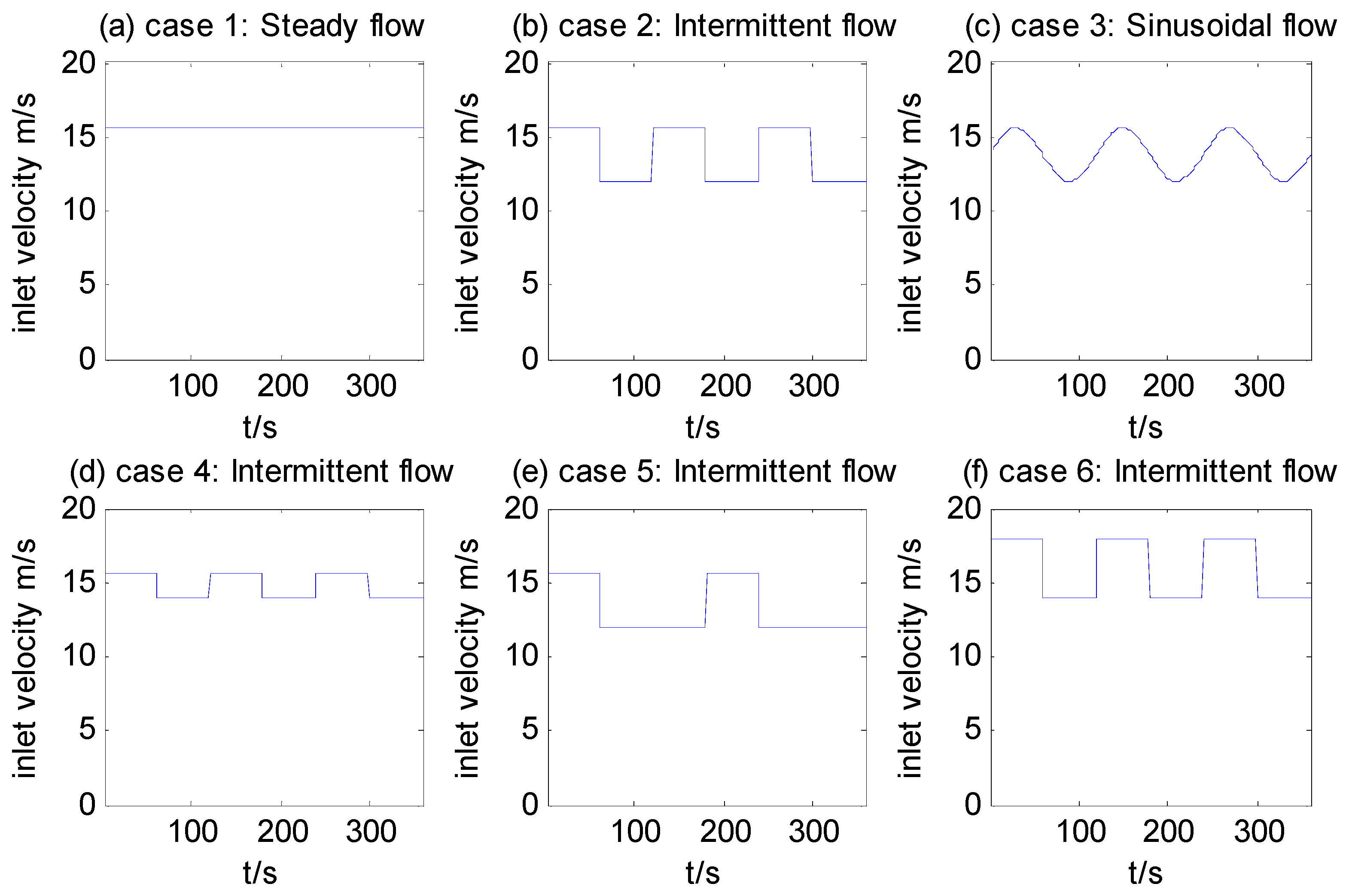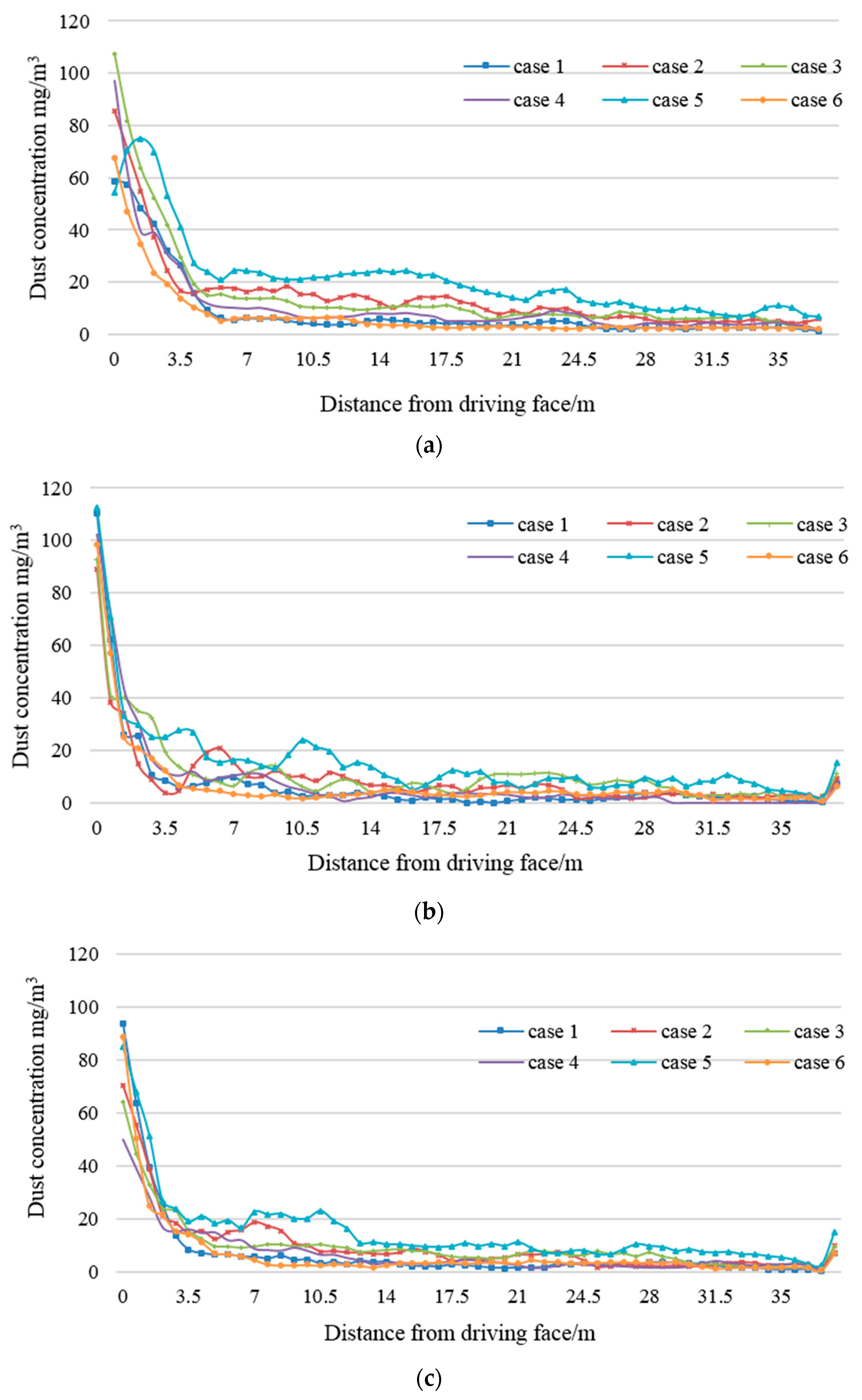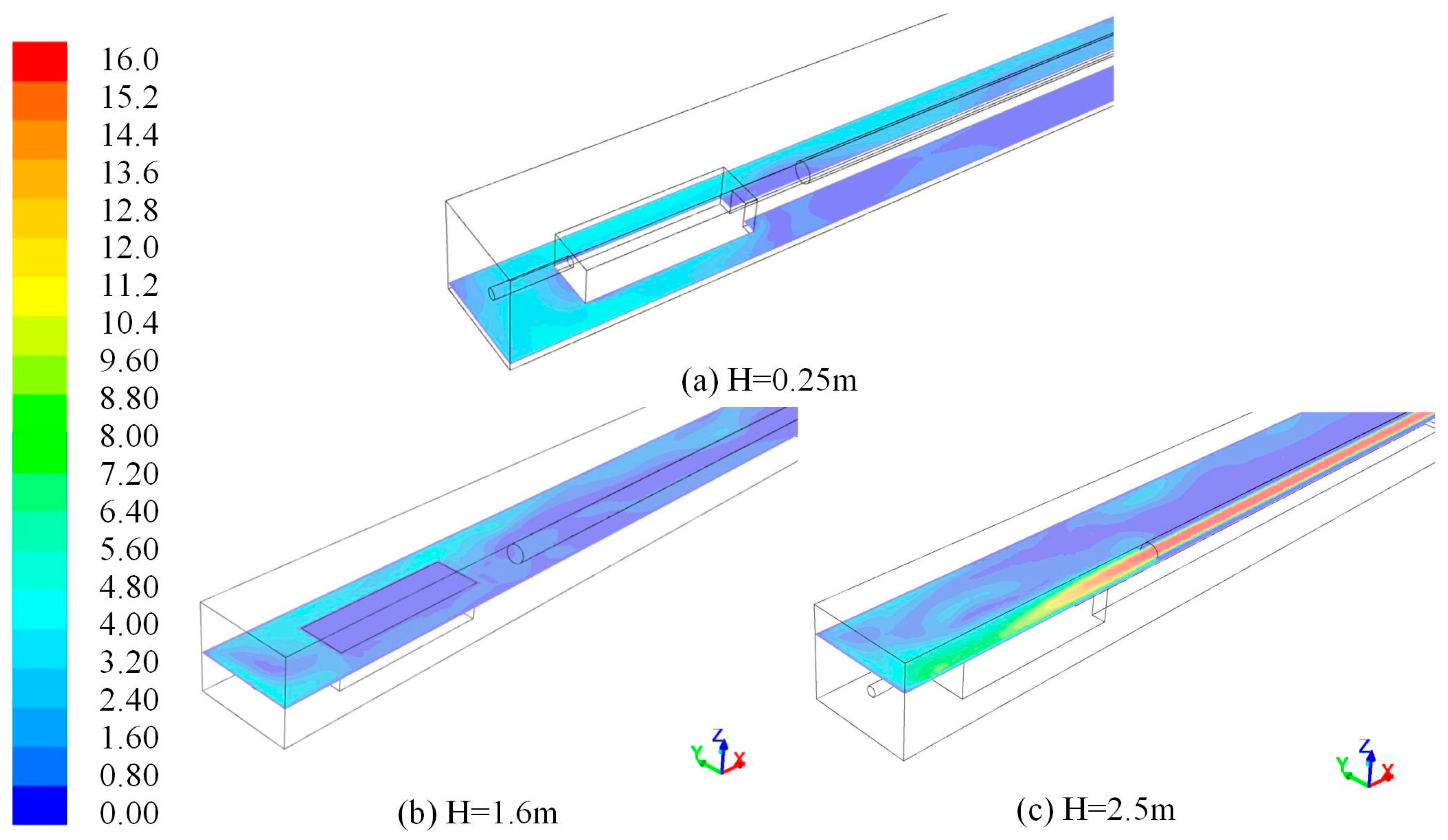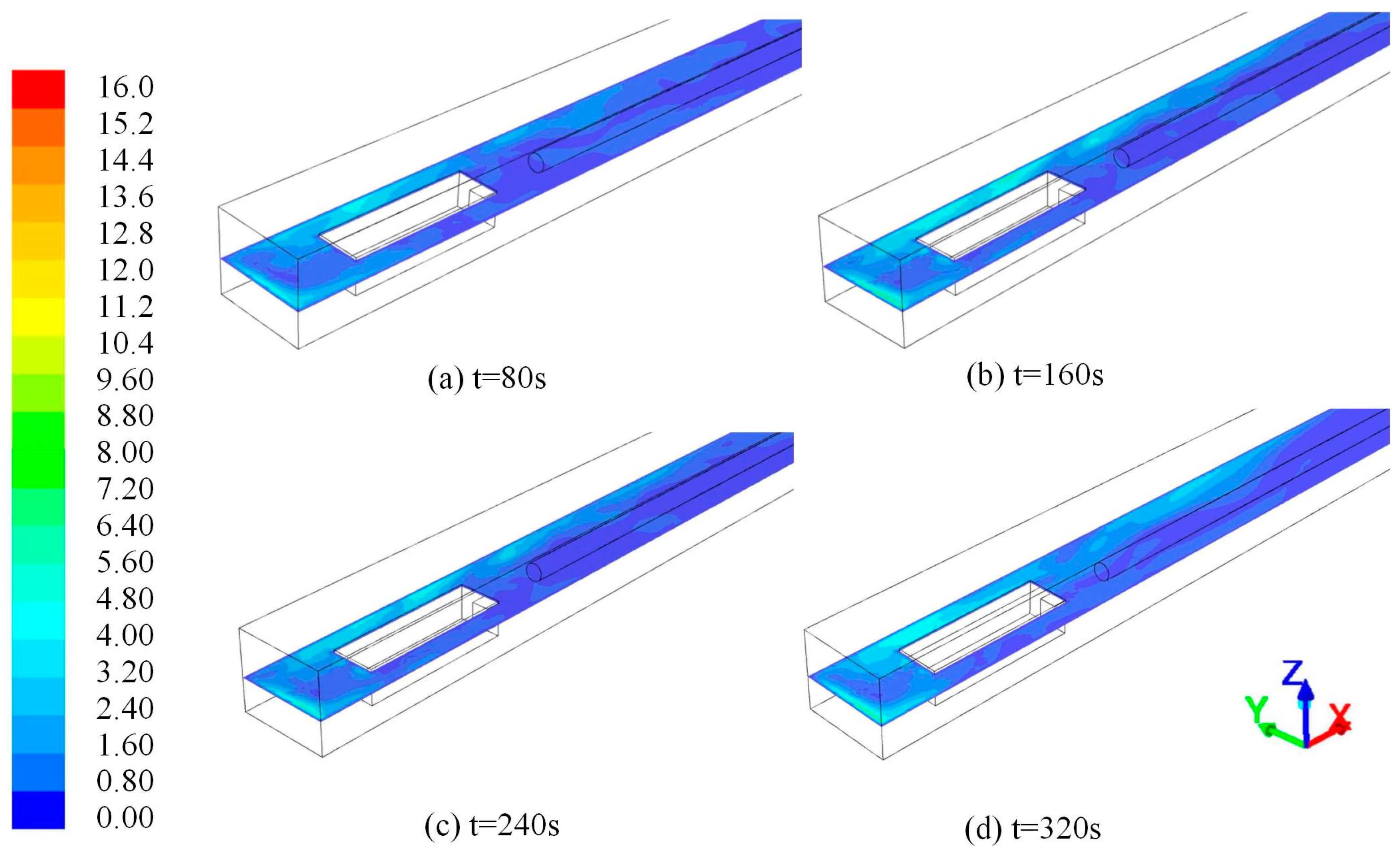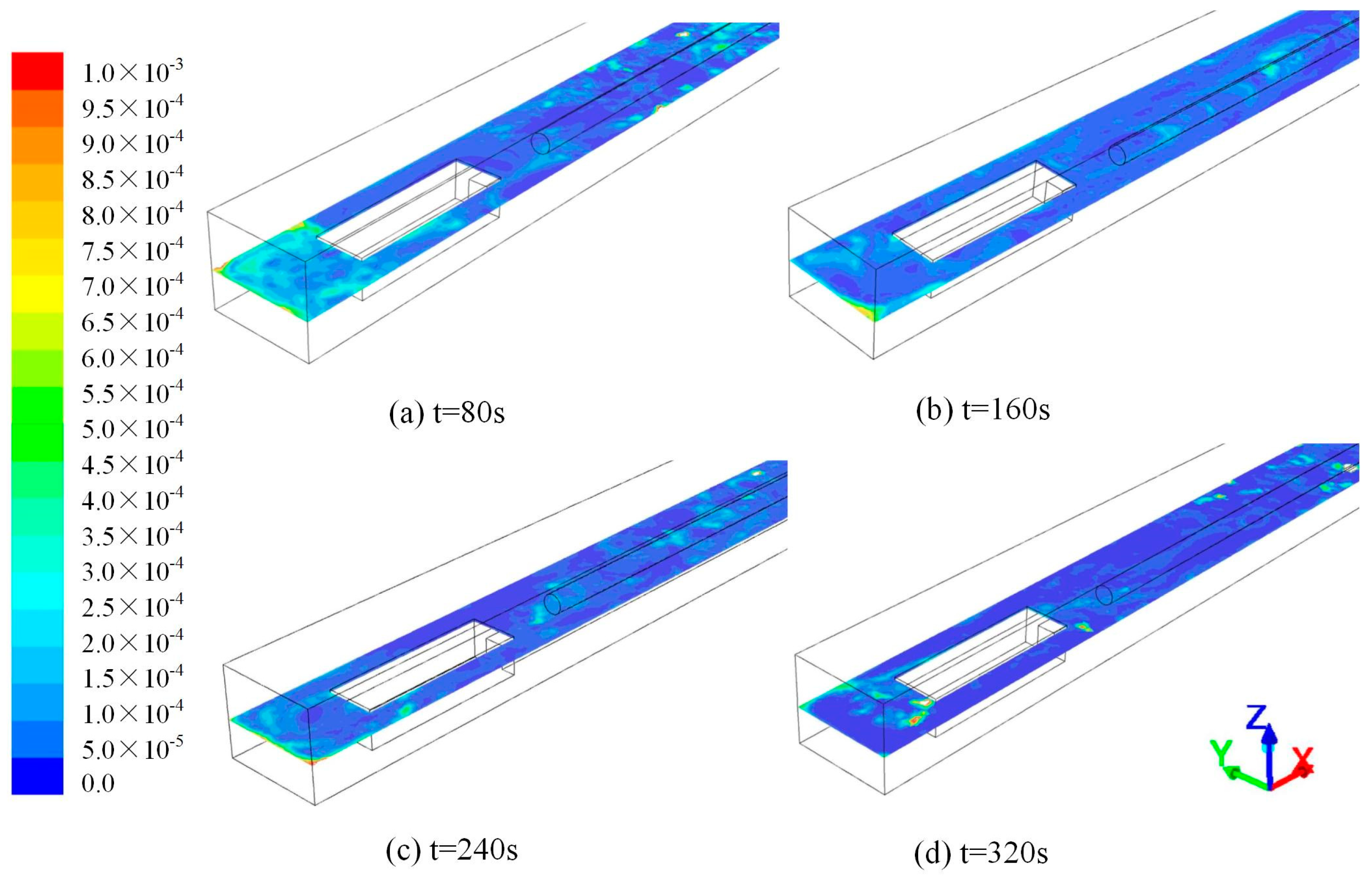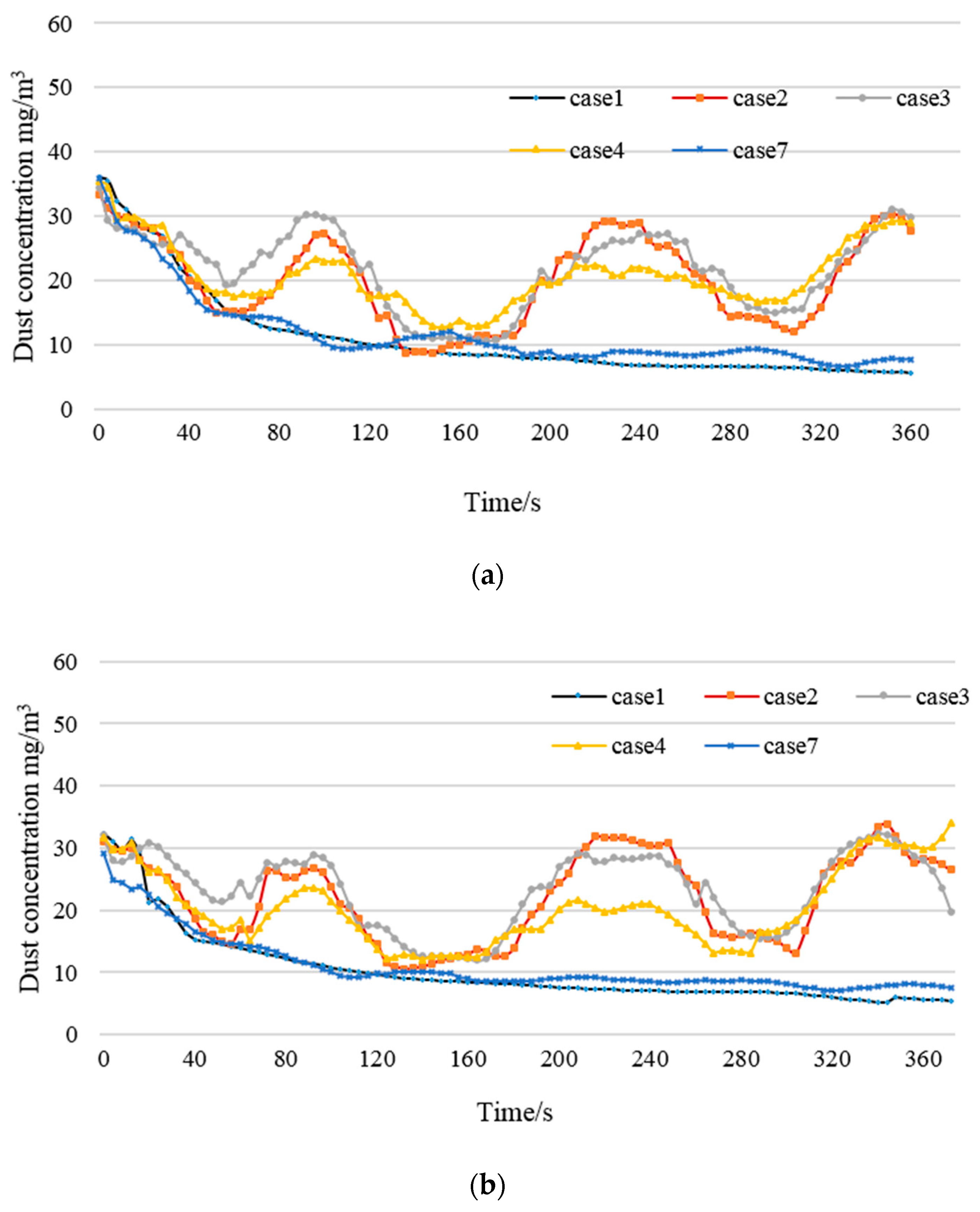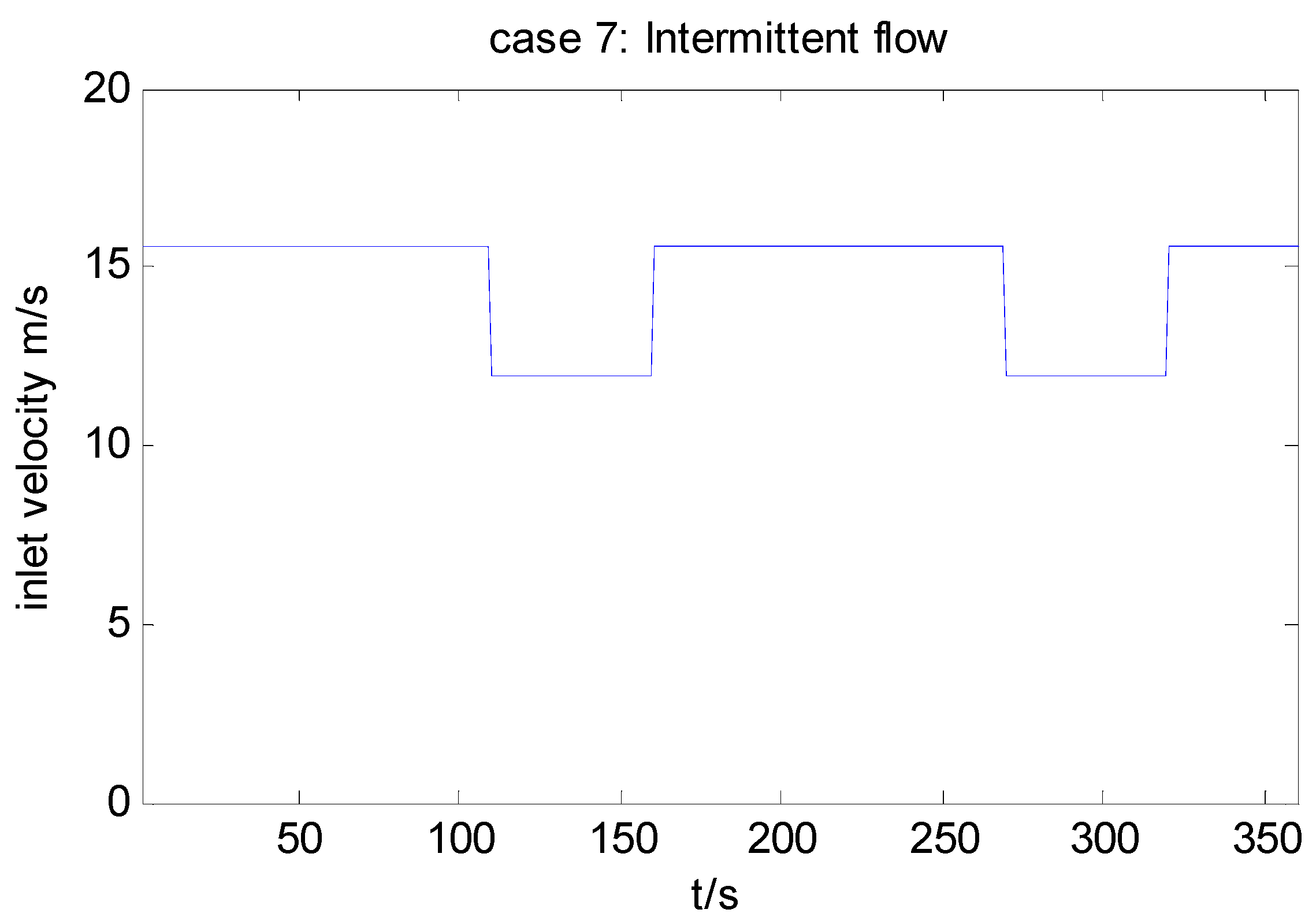4.1. Time Varying Ventilation Strategy and Parametric Studies
In this section, the temporospatial characteristics of air flow and dust distribution with time varying velocities are investigated. Various configurations of innovative time varying ventilation systems are introduced and discussed.
In order to provide coal miners with sufficient fresh air and ensure dust concentration in a safe level, most underground mines typically utilize large main fans to ventilate airflow to other branches, which generally provides excessive amount of fresh air to various locations in underground working environment. The operation regulations of Tianchen coal mine indicate that the required airflow in 3-7109 laneway is 7.82 m
3/s, so the velocity of airflow in forcing duct is 15.6 m/s. It requires massive electrical energy to power the fan when this approach is adopted. Here, based on parametric studies, we proposed five possible time varying ventilation designs to save energy whilst ensure a safe environment, and their performance in terms of the possible energy saving and dust control efficiency are tested and compared with the steady flow ventilation system. Specifically, each ventilation system has different dynamic patterns of inlet velocity, which are illustrated in
Figure 7: (case 1,
Figure 7a) steady flow with 15.6 m/s velocity; (case 2,
Figure 7b) 60 s high velocity (15.6 m/s) and 60 s low velocity (12 m/s); (case 3,
Figure 7c) defined as sinusoidal flow, for which the velocity changing curve is defined as the sine law with period of 120 s, its peak value and valley value is 15.6 m/s and 12 m/s, respectively; (case 4,
Figure 7d) 60 s high velocity (15.6 m/s) and 60 s low velocity (14 m/s); (case 5,
Figure 7e) 60 s high velocity (15.6 m/s) and 120 s low velocity (12 m/s), and (case 6,
Figure 7f) 60 s high velocity (18 m/s) and 60 s low velocity (14 m/s).
Six ventilation patterns were simulated based on the computational fluid dynamic platforms. At first, we look into coal dust distribution characteristics along the mining laneway in different time points. Considered that miners typically breathe at the average height of 1.5 m, which is defined as the breathing zone. So a line in this height in section A was selected to detect dust concentration among the six ventilation patterns. The variation trend of dust concentration along the laneway was presented in
Figure 8 at time points 60, 120 and 180 s. There are several apparent features: with the increasing laneway length, dust concentration under six different ventilation patterns were pushed into the area near the driving face, mirrored by high concentration on first few meters from the mining face and the slightly decreasing trend of dust concentration. Coal dust concentration is maintained at a low level on average. It can also be found that at 60 s, coal dust is relatively high and distributed fully inside the laneway; and maintain steadily around the safe level at 120 s; and keep under the safe level at 180 s.
Considered that miners usually work at the position with the distance of farther than 7 m away from the driving face. It is clear that at 180 s, the dust concentration in case 1, case 4 and case 6 is lower than the limit value of 5 mg/m3 when it is father than 7 m away from driving face. Accordingly, the computed average dust concentration at 120 s along the selected line for case 1~6 are 7.00, 9.17, 11.12, 8.06, 15.17, and 6.20 mg/m3, and dust concentration for case 2~6 increased up to 31.08%, 58.84%, 15.10%, 92.51% and −11.42% compared with base case, respectively. The same figure at 180 s for case 1~6 are 7.29, 9.84, 9.64, 7.98, 13.98, and 6.97 mg/m3, and dust concentration for case 2~6 increased up to 35.11%, 32.26%, 9.4%, 91.7% and −4.5% compared with base case respectively. Overall, it can be concluded that case 6 performs best among other patterns in handling dust emission by mitigating it away from the driving face.
It is found that the ventilation system with time varying velocity cannot apparently improve dust removal efficiency compared with steady flow, however, it offers potential in terms of energy savings and guarantees that the average dust concentration can still be decreased to a low level, which confirms that continuous high-speed ventilation typically used in underground mine really leads to the waste of energy consumption. As presented in
Table 4, the significant amount of energy saving and other parameters on average are calculated based on Bernoulli equation within 360 s, which are presented here.
where
is the pressure difference,
is the standard atmospheric pressure and
is the pressure at the cross section of the laneway.
is the volumetric flow rate in the blast, and
is the cross-sectional area of the blast.
is the fan power needed in this model.
and
are variables at two different intervals (
t1 and
t2) in a velocity changing period, where
represents different variables
,
,
and
, and
is the mean value of the variables.
The energy saving for case 2~5 is 27.20%, 27.20%, 13.80% and 36.26% respectively, while case 6 performs worse in energy saving as it constitutes to negative saving (more power is required), which is neglected in the following study. Besides,
Figure 8 shows that the dust concentration for case 5 is higher than other cases, which performs worse in dust control efficiency due to its long period of low ventilation velocity, so this case is also neglected in the following study. Hence, considered the dust removal efficiency of those three cases, it can be concluded that case 4 offers a balanced performance for it reduced energy usage up to 13.8% whilst keeping coal dust concentration at low level (the average dust concentration is slightly increased by 15.10% and 9.4% along the monitored line at 120 and 180 s). The results indicate that it is really necessary to apply time varying ventilation and dust control system in practical application. Besides, the further understanding of dynamic regularity of dust movement and its distribution inside the laneway is also essential for the design of ventilation patterns.
4.2. The Temporospatial Characteristics of Airflow and Dust Distribution
The velocity field of air flow is one of the main factors which is expected to directly influence dust dispersion and mitigation. In this section, we take ventilation pattern with intermittent flow (case 2) as an example to investigate the dynamic characteristics of the airflow and dust distribution.
As presented in
Figure 9, the airflow velocity profiles at the height of 0.25, 1.6 and 2.5 m were investigated, the pressing air is discharged from the forcing duct at high velocity, and there exists an obvious jet flow, which goes along the laneway and flows to the driving face. When the air arrives at the heading face, it is obstructed by the face, hence the impact jet flow forms. After that, the air changes its flow direction and the air velocity gradually decreases along the outtake airflow roadway.
Figure 10 and
Figure 11 present the predicted velocity profiles and dust distribution at breathing zone for four time points with the fixed dust generation rate of 0.0042 kg/s. As we explored the overall temporospatial characteristics of velocity behaviour and dust distribution inside the laneway: with the action of the pressing air, a great amount of dust particles are dispersed and driven to the outtake side of airflow roadway (
Figure 11a), it is obvious that the volume fraction of dust particles is far bigger near the heading face on the outtake side than the other parts. While after 80 s, dust particles are diluted along the whole laneway and distributed uniformly with low concentration.
Overall, the results indicate that the dynamic patterns of ventilation perform well in energy saving but not ideal in dust control and management. Therefore, an improved time varying design should be developed and more parametric research need to be studied in order to enhance dust removal efficiency.
4.3. The Most Efficient Ventilation Pattern
In the previous parametric studies, we have studied the potential energy saving for the time varying ventilation patterns. However, in order to investigate the changing regularity of dust concentration, a number of simulations are conducted to optimize the parameters. An important finding is that the velocity value and duration of periodic changes in ventilation velocity plays an important role in dust removal efficiency. Considered the positions where miners typically work, two points (10 m away from the driving face) at Sections A and C with the breathing height of 1.5 m are monitored, where the dust concentration is compared for different time varying ventilation patterns. The results suggest that high speed of velocity in an intermittency duration (case 4) yields relatively low dust concentration as compared to other intermittent scenarios (cases 2 and 3). This is attributed to the dust accumulation during low velocity ventilation, which alleviates higher dust concentration. When looking to the duration of periodic changes in ventilation velocity, we found that changing this factor can lead to very different dust concentration. Then it comes to a question of whether we can we find a key time point at which the dust concentration almost cannot be affected by the velocity that is changed slightly in an intermittent period? The answer is right. Considered the fact that in this study, after 110 s, the dust concentration in base case 1 (steady flow) decreases very slowly and maintains at a stable level. This phenomenon illustrates the dust removal efficiency with continuously high speed velocity is not significant anymore, so the ventilation velocity can be decreased slightly to save energy consumption. Therefore, we set velocity as 12 m/s after 110 s and observed the corresponding concentration tendency. As presented in
Figure 12, the dust concentration in case 7 is slightly increased after 110 s, this is attributed to the dust accumulation during low velocity. Therefore, the velocity needs to be increased, the simulation result demonstrates that 160 s is the key time point and increasing velocity at this time point will control dust concentration at a low level. Thus, this case is defined as case 7: 110 s high velocity (15.6 m/s) and 50 s low velocity (12 m/s), as presented in
Figure 13. The result in
Figure 12 shows the dust concentration changes with different velocity and duration period, which demonstrates that case 7 can perform as well as the steady flow, and 110 and 160 s are defined as the key time points.
The base model of case 1 must be validated before accepting the results for field guidance. In this experiment, the dust monitor of type GCG1000 was paced at the height of the breathing zone (1.5 m above floor) and at 20 m away from the driving face inside the 3-7109 laneway in Tianchen coal mine. The measured data was used for model validation. The safety and operation regulations of Tianchen coal mine indicates that free silica dioxide content is lower than 5%, so the maximum allowable total dust concentration is 5 mg/m
3, as can be seen in
Table 5. Specifications of the dust monitor with type GCG1000 is shown in
Table 6.
Figure 14 illustrates the comparison among simulation results in case 1 and field measured data. It can be seen that good agreement between the two sets of data has obtained. They all exhibit a declining tendency and indicate that dust concentration is diluted and expelled out of the laneway. The measured result demonstrated that the dust concentration in this point is lower than the limit values, indicating that the dust quality has remained the standard.
Similarly, the potential energy savings for case 7 is shown in
Table 7, and it reduces energy consumption up to 15.11%. The results indicate that case 7 offers the best performance, as it saves energy consumption whilst keeping coal dust concentration at a low level, which shows a potential for practical application.

